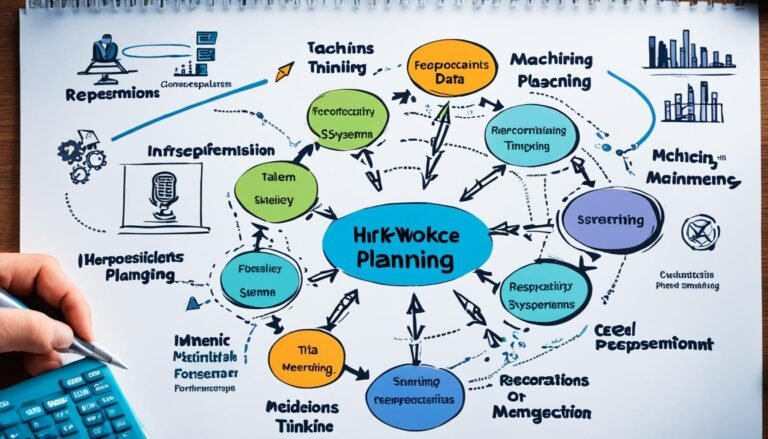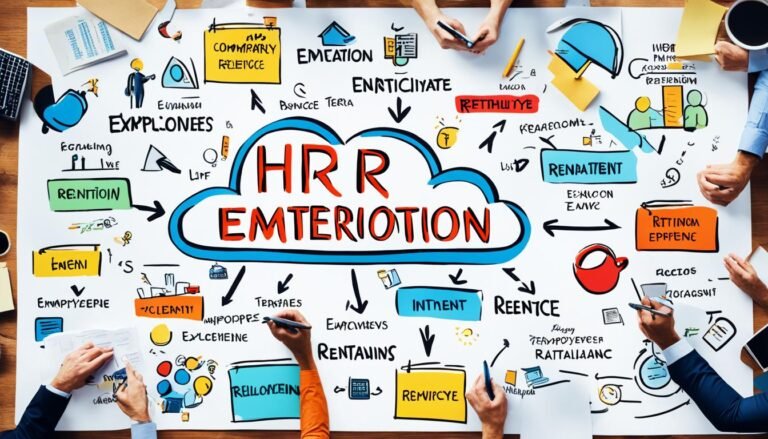A Guide to Human Resource Management Challenges and Solutions
Welcome to our comprehensive guide on human resource management (HRM) challenges and solutions. As HR professionals, you face a variety of obstacles in effectively managing your organization’s most valuable asset: its people. From attracting and retaining top talent to addressing diversity issues and managing change, navigating these challenges requires strategic thinking and innovative solutions. In this guide, we will explore the key challenges faced by HR professionals and provide practical solutions to overcome them. Let’s dive in!
Key Takeaways:
- HR professionals face various challenges in managing human resources.
- Attracting and retaining top talent is crucial for organizational success.
- Building a value-oriented company culture promotes employee engagement and satisfaction.
- Cultural diversity in the workplace enhances innovation and inclusivity.
- Effectively managing change requires transparent communication and adaptability.
What is Human Resource Management?
Human resource management (HRM or HR) is the strategic approach to effectively managing people in a company or organization to gain a competitive advantage. The HR department’s primary role is to hire new talent and manage internal resources. HR professionals aim to maximize employee performance in alignment with the company’s strategic objectives.
According to Wikipedia, HRM is defined as:
“The strategic and coherent approach to the management of an organization’s most valued assets – the people working there who individually and collectively contribute to the achievement of its objectives. The HRM focuses on the policies, systems, and processes that influence employee behavior, attitudes, and performance.”
Human resource management involves various functions, including:
- Recruitment and selection
- Training and development
- Performance management
- Compensation and benefits
- Employee relations
- Strategic planning
By strategically managing human resources, organizations can improve employee performance, enhance productivity, and ultimately gain a competitive advantage in the market.
One of the key aspects of HRM is its focus on aligning employee performance with the company’s strategic goals. HR professionals work closely with managers and executives to develop performance measurement systems, set performance targets, and implement strategies to improve employee productivity. By effectively managing employee performance, organizations can achieve higher levels of success and drive business growth.
Additionally, HRM plays a crucial role in creating a positive work culture and fostering employee engagement. Through various initiatives such as employee recognition programs, flexible work arrangements, and opportunities for professional development, HR professionals can create an environment where employees feel valued, motivated, and inspired to perform at their best.
Role of HRM in Driving Competitive Advantage
Human resource management is instrumental in helping organizations gain a competitive advantage. By strategically managing human capital and fostering a high-performing workforce, HRM contributes to the overall success and profitability of the company.
Here are some ways in which HRM can drive competitive advantage:
- Attracting and Retaining Top Talent: HR professionals play a crucial role in attracting and retaining top talent in the industry. By implementing effective recruitment strategies, developing employer branding initiatives, and providing competitive compensation and benefits packages, HRM can attract high-caliber candidates and retain them in the long term.
- Enhancing Employee Performance: Through performance management systems, training and development programs, and continuous feedback, HRM helps optimize employee performance and productivity. This leads to increased efficiency and effectiveness in achieving organizational goals.
- Creating a Culture of Innovation: HRM promotes a culture of innovation and creativity within the organization. By fostering a supportive environment, encouraging idea-sharing, and implementing initiatives for employee empowerment, HRM enables employees to contribute their unique perspectives and ideas, driving innovation and staying ahead of competitors.
- Adapting to Change: HRM plays a crucial role in managing organizational change. By facilitating effective communication, providing change management training, and supporting employees through periods of transition, HRM helps organizations adapt to market changes and maintain a competitive edge.
Overall, human resource management is a strategic function that plays a critical role in driving organizational success. By effectively managing people, HRM enables companies to leverage their human capital, enhance employee performance, and gain a competitive advantage in their respective industries.
Insights into HR Statistics
Understanding HR statistics can provide valuable insights for HR professionals to make informed decisions. In this section, we will explore key statistics that shed light on various aspects of human resource management.
The Difficulty of Finding the Right Employee
A significant challenge faced by HR departments is finding the right employee for a job vacancy. With increasing competition from other employers, it has become more difficult to attract and retain top talent. This challenge is evident in the following statistic:
| Statistic | Percentage |
|---|---|
| Difficulty finding the right employee | 67% |
This data highlights the steep competition in the job market and emphasizes the importance of implementing effective recruitment and selection strategies.
Job Seekers Leaving Within the First 90 Days
Retaining new hires is another significant challenge for HR departments. Unmet expectations and poor onboarding processes can lead to job seekers leaving within the first 90 days of employment. The following statistic illustrates this issue:
| Statistic | Percentage |
|---|---|
| Job seekers leaving within the first 90 days | 45% |
This data highlights the importance of providing a positive onboarding experience and setting realistic expectations to ensure long-term employee retention.
The Prevalence of Employee Burnout
Employee burnout is a growing concern in today’s fast-paced work environments. The following statistic sheds light on the prevalence of burnout among employees:
“A recent survey found that 65% of employees experience burnout at work.”
This alarming statistic emphasizes the need for organizations to prioritize employee well-being and implement strategies to prevent and manage burnout.
The Need for Diversity in Companies
Diversity in the workplace is crucial for fostering innovation, creativity, and a positive work environment. The following statistic highlights the importance of diversity:
“Companies with diverse workforces are 35% more likely to outperform their industry peers.”
This statistic emphasizes that organizations should actively promote diversity and inclusion initiatives to gain a competitive advantage and drive success.
The Impact of Company Culture on Job Seekers
Company culture plays a significant role in attracting and retaining top talent. The following statistic demonstrates the impact of company culture on job seekers:
“74% of job seekers consider company culture before applying for a job.”
This data highlights the importance for organizations to cultivate a positive and engaging company culture to attract and retain top talent.
Retaining Top Talent
Retaining top talent is essential for the long-term success of an organization. To achieve this, companies need to implement effective strategies that promote employee retention, recognize and reward exceptional performance, and foster leadership development.
One crucial aspect of retaining top talent is creating a work environment that values and appreciates employees. By recognizing and promoting individuals based on their merit, companies can inspire a sense of loyalty and motivation among their employees, ultimately reducing turnover.
Furthermore, treating all employees equally and providing them with growth and development opportunities is instrumental in retaining top performers. Employees who feel valued and see a clear path for advancement within the organization are more likely to stay committed to their roles and contribute to company success.
“Attracting and retaining the right talent is critical to any company’s success. This requires providing employees with opportunities for professional growth and development, as well as creating a culture that supports their aspirations and ambitions.”
Effective leadership development programs also play a significant role in retaining top talent. These programs focus on cultivating leadership skills and competencies among employees, creating a culture of continuous learning and professional growth.
The Benefits of Leadership Development Programs
Leadership development programs offer numerous benefits that contribute to retaining top talent. These benefits include:
- Enhanced employee engagement and job satisfaction
- Increased productivity and efficiency
- Improved employee morale and motivation
- Greater organizational agility and adaptability
- Strengthened succession planning and future leadership pipeline
By investing in leadership development initiatives, companies can demonstrate their commitment to employees’ professional growth, effectively retaining and nurturing top talent.
Implementing strategies to retain top talent requires a comprehensive approach that encompasses various aspects of employee management. From recognition and rewards to leadership development, organizations that prioritize employee retention can create a competitive advantage in the market.
| Key Strategies for Retaining Top Talent | Benefits |
|---|---|
| Treating all employees equally | Creates a positive work culture and fosters loyalty |
| Recognizing and promoting based on performance | Boosts employee morale and motivation |
| Providing growth and development opportunities | Increases employee satisfaction and engagement |
| Implementing leadership development programs | Develops a pipeline of future leaders and enhances organizational agility |
By prioritizing employee retention and offering opportunities for growth and development, organizations can create a thriving and engaged workforce capable of driving long-term success.
Attracting Top Talent
To attract top talent, companies need to focus on various strategies to stand out in a competitive job market. Building a strong employer brand, providing professional development opportunities, and leveraging recruitment resources are key factors in attracting the right candidates.
Building a Strong Employer Brand: Companies should promote their unique company culture and values to create an attractive employer brand. This involves highlighting the company’s mission, vision, and commitment to diversity and inclusivity. By communicating these aspects, companies can appeal to candidates who align with their values.
Professional Development Opportunities: Offering professional development opportunities is crucial for attracting top talent. Companies should invest in training programs, mentorship initiatives, and continuous learning opportunities to showcase their commitment to employee growth. This not only attracts skilled professionals but also demonstrates a company’s dedication to nurturing talent.
Leveraging Recruitment Resources: Online job portals and resume databases are valuable recruitment resources that can help companies tap into a larger pool of talent. By utilizing these platforms effectively, companies can increase their visibility and reach among job seekers. Additionally, leveraging social media and professional networking sites allows companies to connect with passive candidates who may not actively search for job opportunities.
“A strong employer brand, professional development opportunities, and effective recruitment resources are vital in attracting top talent.”
By implementing these strategies, companies can enhance their chances of attracting highly skilled professionals who are aligned with their organizational goals and values.
Recruitment Resources Comparison:
| Recruitment Resource | Advantages | Disadvantages |
|---|---|---|
| Online Job Portals |
|
|
| Resume Databases |
|
|
Building Leadership Within the Team
Lack of leadership can demotivate employees and hinder their growth. In order to foster a culture of personal and professional growth, HR departments can implement various strategies to build leadership within the team.
Cross-Training Programs
Cross-training programs provide employees with opportunities to develop and expand their skill sets. By exposing employees to different roles and responsibilities within the organization, cross-training nurtures their leadership potential and provides a broader understanding of the business. It also encourages collaboration and teamwork, as employees gain a deeper appreciation for the roles played by their colleagues.
Certification Programs
Implementing certification programs can empower employees to enhance their expertise and leadership abilities. These programs offer specialized training and educational opportunities that align with the company’s goals and industry standards. By obtaining certifications, employees not only acquire valuable knowledge and skills but also gain recognition within the organization, boosting their motivation and confidence.
Specialized Projects
Assigning employees to specialize in specific projects allows them to take ownership and demonstrate their leadership potential. These projects can focus on areas that align with their interests and skills, enabling them to showcase their abilities and create a positive impact on the organization. By providing employees with opportunities to lead and execute specialized projects, HR departments not only nurture leadership qualities but also foster innovation and growth.
Cultivating leadership within the team is essential for employee motivation, personal development, and the overall success of the organization. By offering cross-training programs, certification programs, and specialized projects, HR professionals can empower employees to take charge, contribute effectively, and thrive in their roles.
Creating a Value-Oriented Company Culture
Company culture plays a vital role in employee engagement and satisfaction. When employees feel aligned with the values and mission of the organization, they are more likely to be motivated and productive. A value-oriented culture not only attracts top talent but also empowers employees to contribute their best work.
Employee Empowerment
Empowering employees means giving them the autonomy and authority to make decisions and take ownership of their work. When employees feel trusted and empowered, they are more likely to be engaged and committed to achieving the company’s goals. This can be achieved through delegation of authority, encouraging innovative thinking, and providing opportunities for professional development and growth. By investing in their employees, companies can cultivate a sense of ownership and pride, leading to increased productivity and better overall performance.
Recognition and Incentives
Recognition is a powerful motivator that reinforces positive behaviors and achievements. By acknowledging and appreciating employee contributions, companies can boost morale, job satisfaction, and loyalty. This can be done through various means, such as employee of the month programs, public acknowledgments, or rewards and incentives for exceptional performance.
Incentives are another effective way to create motivation and reward employees for their hard work. These can include financial rewards, bonuses, performance-based salary increases, or non-monetary rewards like extra vacation days or professional development opportunities. By implementing a well-designed recognition and incentive program, companies can foster a culture of appreciation and excellence.
A value-oriented company culture focuses on employee empowerment, recognition, and incentives as key drivers of engagement and growth. When employees feel valued and appreciated, they become more committed to achieving the company’s objectives, leading to better business performance.
Bridging Cultural Differences
In today’s globalized world, embracing cultural diversity in the workplace is crucial for organizational success. As companies expand their operations internationally, they encounter cultural differences that can impact effective communication and collaboration. Human resource (HR) departments play a vital role in bridging these cultural differences and creating a harmonious work environment.
Effective communication is key to overcoming cultural barriers and fostering understanding among employees from different backgrounds. HR professionals can facilitate effective communication by encouraging open dialogue, providing language training, and promoting cultural competency programs. By enhancing communication skills, employees can bridge the gap between cultural differences and work cohesively towards shared goals.
“Cultural competence is not about being an expert on every culture, but rather about having the willingness and ability to learn, adapt, and respect cultural differences.”
Highlighting Cultural Efforts and Practices
Recognizing and celebrating cultural efforts and practices within the organization can create a sense of inclusivity and appreciation among employees. HR departments can organize cultural events, establish employee resource groups, and encourage cross-cultural interaction. By valuing and respecting different cultures, companies can foster a positive work environment that encourages diversity and promotes innovative thinking.
Networking and Learning Opportunities
Networking opportunities are invaluable for fostering connections and understanding among employees from different cultural backgrounds. HR departments can organize networking events, mentorship programs, and cross-cultural training sessions. These initiatives provide employees with the chance to broaden their perspectives, exchange ideas, and form meaningful relationships. Moreover, investing in learning opportunities empowers employees to enhance their cross-cultural competence and adaptability.
Diversity and Inclusion
Emphasizing diversity and inclusion is vital for effective cultural integration. HR departments must prioritize diversity in recruitment and ensure equal opportunities for all employees. By promoting equality, respect, and understanding, organizations can harness the collective strengths and perspectives of a diverse workforce. Inclusive policies and practices create a more dynamic and innovative work environment that drives success.
| Benefits of Cultural Diversity in the Workplace | Effective Communication Strategies |
|---|---|
| Enhanced creativity and innovation | Active listening |
| Improved problem-solving skills | Using visual aids and gestures to supplement verbal communication |
| Increased adaptability and flexibility | Respecting different communication styles |
| Broader global perspective | Providing language training and translation services |
| Expanded market reach and customer understanding | Promoting cultural competency programs |
Bridging cultural differences requires a proactive approach from HR departments. By promoting effective communication, highlighting cultural efforts and practices, providing networking and learning opportunities, and emphasizing diversity and inclusion, organizations can foster a more inclusive and innovative work environment. Understanding and embracing cultural diversity not only enhances employee engagement and satisfaction but also contributes to organizational growth in an increasingly interconnected world.
Handling Change Management
Change management can be a significant challenge for HR departments, as employees often exhibit resistance and apprehension towards change and its potential impact. However, HR professionals can overcome this challenge by implementing effective strategies focused on communication, employee involvement, prompt issue resolution, and fostering adaptability within the workforce.
Transparent and open communication is essential when managing change. Providing clear and concise information to employees about the reasons behind the change, its expected outcomes, and the support available will help alleviate concerns and build trust. By actively involving employees in the decision-making process and seeking their input, HR professionals can ensure a sense of ownership and encourage buy-in from the workforce.
Addressing concerns promptly is crucial to managing employee resistance effectively. HR professionals should actively listen to employees’ feedback, acknowledge their concerns, and provide timely and thoughtful responses. By addressing these concerns and implementing appropriate measures, HR professionals can cultivate a supportive environment conducive to change and minimize resistance.
To navigate change successfully, organizations must cultivate adaptability within their workforce. Encouraging employees to develop and enhance their skill sets, fostering a growth mindset, and providing training opportunities will enable employees to adapt more easily to new processes, technologies, and working styles.
Managing cultural diversity smartly is another critical aspect of change management. HR professionals should consider the impact of change on different cultural groups within the organization and develop strategies to address potential challenges. By recognizing and valuing diverse perspectives and aligning changes with performance assessments and other relevant factors, organizations can facilitate a smooth transition and ensure that change initiatives are implemented successfully.
Conclusion
Managing human resources can be challenging, but with effective strategies and solutions, HR professionals can overcome these obstacles. By focusing on attracting and retaining top talent, building strong leadership, cultivating a value-oriented company culture, addressing cultural differences, and effectively managing change, organizations can achieve effective HR management. Embracing digital transformations, emphasizing reskilling and upskilling, and promoting digital dexterity are also key factors in successful HR practices.
By understanding and addressing these HR challenges, organizations can optimize their HR management and drive overall success. The ability to attract and retain top talent ensures a competitive advantage, while building leadership within the team fosters growth and motivation. Creating a value-oriented company culture empowers employees and enhances business performance. Addressing cultural differences helps create an inclusive work environment, while effectively managing change leads to successful organizational transformations.
In the ever-evolving landscape of HR, staying adaptable and embracing new technologies is essential. By utilizing effective HR strategies, organizations can overcome challenges, foster employee growth and satisfaction, and drive overall success. With effective HR management, organizations can navigate the complexities of human resources and thrive in today’s dynamic business environment.







